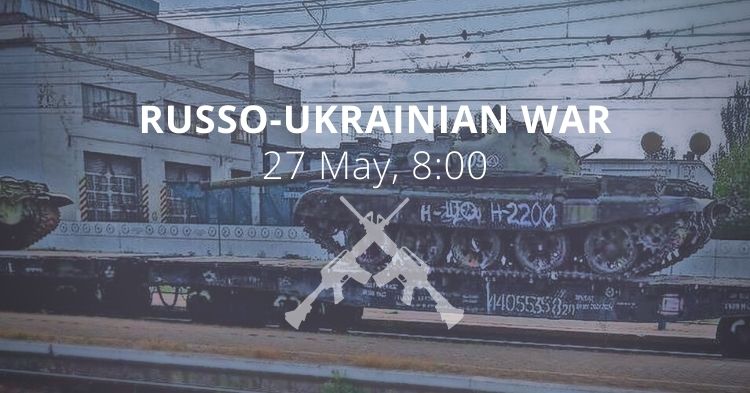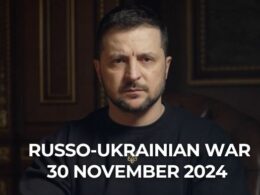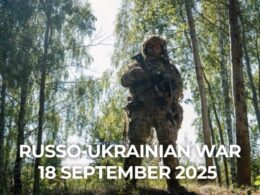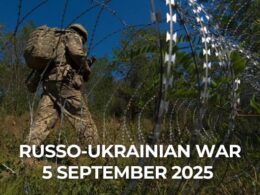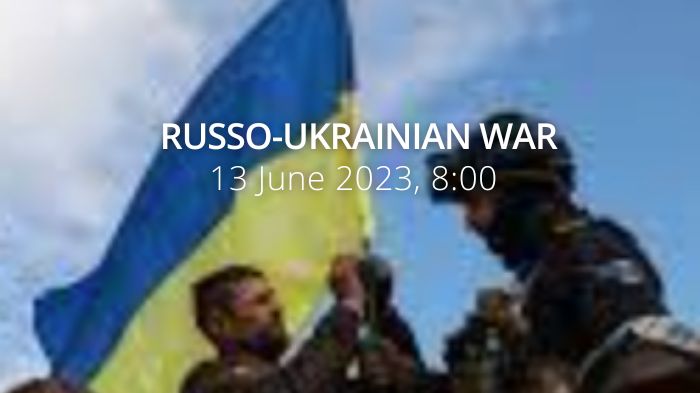Fighting in the Donbas has hit its fiercest point, Kyiv says, as Russia slowly advances towards Sievierodonetsk, Lysychansk, Bakhmut. Ukrainian officials repeat calls for weapons. Russia plans to force crossing over Siverskyi Donets in the Donbas, brings tanks designed 60 years ago to Ukraine's south where it prepares a third defense line. Belarus created a "Southern Operational Command" near Ukrainian borders. Putin promises to downplay the food crisis that he has created in exchange for lifting Western sanctions against Russia.
Situation

On May 26, Belarusian dictator Alyaksandr Lukashenka announced the establishing of a "southern operational command" in the Ukrainian direction, which may show that the countdown to the start of his open invasion of Ukraine has begun.
Ukrainian Deputy Defense Minister Hanna Maliar said,
“As of today, the fighting has reached its maximum intensity. The enemy is storming the positions of our troops in several directions simultaneously. We have an extremely difficult and long phase of fighting ahead of us. We must understand that this is a war and losses on our part are inevitable."
Of course, it's about Luhansk Oblast, 95% of which is occupied by the enemy and some Donetsk Oblast's districts.
At the same time, the General Staff says, the Russians reduced the intensity of their offensive in the areas of Avdiivka, Novopavlivka, and Zaporizhzhia, while massing reserves to resume the offensive from Russia's Voronezh and Belgorod oblasts. Those are adjacent to Ukraine's northeastern borders in Sumy, Kharkiv, Luhansk oblasts. In general, the situation on the fronts hasn't changed significantly and the Ukrainian Armed Forces continue to repel the enemy offensive.
The situation remains difficult in Luhansk oblast, where Russian forces continue to press on Sievierodonetsk from the north and south. South of Lysychansk, the Russians have some success in the area of the village of Ustynivka. According to the Russian estimates, there are 4,000 Ukrainian soldiers in Sievierodonetsk and 6,000 in Lysychansk. In reality, of course, there are many fewer of them.
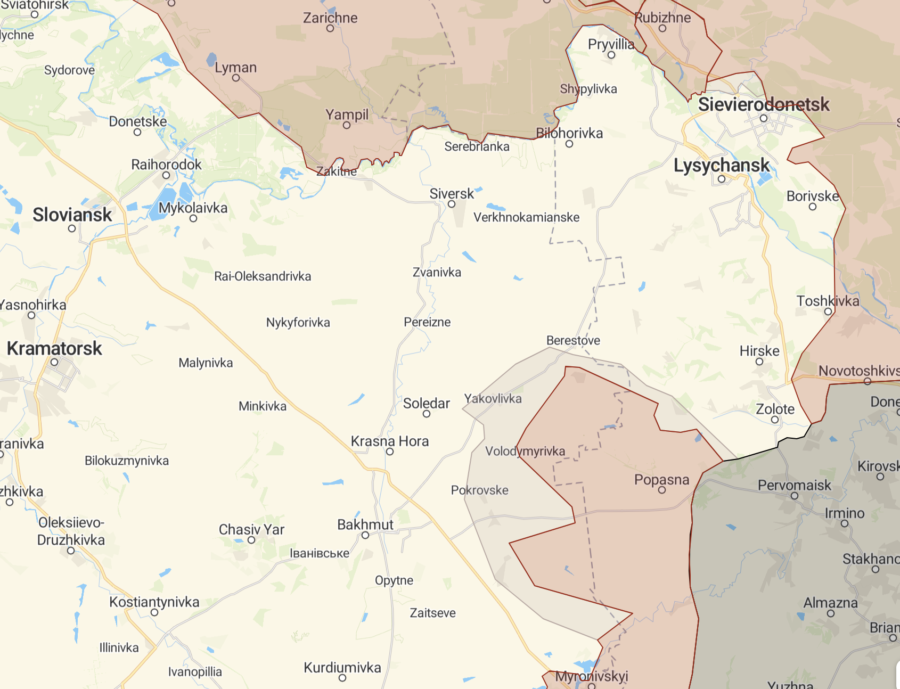
The Bakhmut-Lysychansk highway and other supply routes are are exposed to Russian fire, yet aren't completely blocked.
The Russian offensive from Popasna on Soledar, Bakhmut, and Lysychansk is ongoing, albeit at a slow pace. On the approaches to Bakhmut, the Russians took Pylypchatyne and Midna Ruda, approached Pokrovske and Klynove.
In general, the front runs along the conditional line of Zolotye - Komyshuvakha - Nyrkove - Berestove - Bilohorivka - Yakovlivka - Pokrovske - Klynove. In general, Russians are about 15 kilometers from Bakhmut. Four days ago they were 20 km away, so the pace of the offensive is 5 km in 4 days.
At Izium/Sloviansk, fighting continues for the village of Dovhenke on the northern approaches to Sloviansk. Ukrainian troops have retreated from Lyman.
A look at the control changes in the Donbas over the last 2 weeks.
00:00 Friday 13 May --> 00:00 Friday 27 May pic.twitter.com/SaOMh6irYh
— Ukraine War Map (@War_Mapper) May 27, 2022
No significant developments occurred in other sectors of the front.
A couple of days ago, a video emerged on the Internet showing Russians transporting obsolete T-62 tanks to Ukraine. On 26 May, these tanks surfaced in the Zaporizhzhia direction.
Meanwhile, Ukraine continues to wait for modern offensive weapons from Western allies.
Morning report day 93 – May 27
The report is based on media reports, expert analyses and official information posted online.
Information from the General Staff as of 06.00 27.05.2022, supplemented by its [18:00 assessment] is in the drop-down box below.
There are no significant changes in the activity of units of the Armed Forces of the Republic of Belarus in the Volyn and Polissia direction. Measures to strengthen the protection of the Belarusian-Ukrainian border are underway. The threat of missiles and airstrikes from the territory of the Republic of Belarus remains.
- [Tactical exercises of units of special operations forces, air forces and air defense forces of the Armed Forces of the Republic of Belarus are underway in Brest Oblast.]
In the Siverskyi direction, the enemy continues to take measures to strengthen the cover of the Ukrainian-Russian border in the Bryansk and Kursk oblasts, they are involved in two battalion tactical groups from the airborne troops of the armed forces of the Russian Federation.
- [Russian forces continue to fire mortars and artillery at the positions of the Defense Forces in the border areas of Sumy Oblast.]
In the Slobozhanskyi direction, Russian forces are training personnel for the replenishment of motorized infantry, tank, and artillery units. Inflicts fire damage and conducts remote mining of areas on the routes of possible deployment of units of our troops. [Russian forces did not conduct an active offensive.]
- [In the Kharkiv and Sloviansk directions, Russian forces focus their main efforts on holding the occupied positions and restraining the advance of our troops, shelling the Ukrainian positions. To clarify the position of our troops, it conducted Orlan-10 UAV air reconnaissance. It carried out remote mining on the routes of possible deployment of units of the Defense Forces of Ukraine.]
- In the Kharkiv direction, Russian forces' main efforts are focused on maintaining the occupied positions and restraining the advance of our troops.
- In the Sloviansk direction, Russian occupiers continue to shell the positions of our troops, resuming the offensive.
- [With the support of artillery, Russian forces yesterday led the offensive in the direction of the village of Bohorodychne, had no success and retreated to the position he held earlier.]
- [On the territory of Belgorod and Voronezh oblasts, Russian forces continue to prepare reserves. Replenishes stocks to further resume the offensive.]
In the Donetsk direction, Russian occupiers are conducting active offensive operations. They continue to fire on our units, launch missile strikes and regroup troops.
- The enemy is trying to develop success in the Bakhmut direction, disrupt logistics routes and cut off our units from the main forces.
- In the Lyman direction, Russian forces are conducting reconnaissance, with the support of artillery trying to gain a foothold in the village of Lyman. [Yesterday, Russian forces focused their efforts on the fire damage of our units in the areas of Ozerny and south of the settlement of Lyman.]
- [In the Sievierodonetsk direction, yesterday the enemy was advancing in the directions of the settlements of Sievierodonetsk and Borivske. It is not successful. In the direction of the settlement of Ustynivka, they have partial success. To disrupt logistics and prevent the manoeuvre of our troops, they strike on bridge crossings.]
https://twitter.com/WarMonitor3/status/1529877946646896640
- [In the Bakhmut direction, yesterday Russian occupiers were conducting an offensive in the directions of the settlements of Komyshuvakha, Nyrkove, Berestove, and Bilohorovka, have no success, suffered losses and withdrew. In the directions of Pokrovsky and Klinov, the enemy has partial success, capturing the settlement of Midna Ruda. Performs regrouping.]
- [In the Avdiivka direction, yesterday the enemy tried to resume the offensive, but without success.]
- [In the Kurakhove, Novopavliv, and Zaporizhzhia areas, Russian forces did not conduct active hostilities yesterday.]
- [In the Zaporizhzhia direction, the Russian forces group was additionally reinforced by a formed tank battalion on T-62 tanks.]
- Over the past 24 hours, twelve enemy attacks have been repulsed in the Donetsk and Luhansk directions, a tank, five artillery systems, five units of armored combat vehicles and five cars have been destroyed. The air defense units shot down an enemy Ka-52 helicopter, a cruise missile and an Orlan-10 UAV.
In the Pivdennyi Buh direction, Russian forces continue to take measures to maintain control over the territory of Kherson oblast. Increased the number of shellings of units of our troops, conducts air reconnaissance and carries out engineering equipment positions. Strengthened the group by transferring reserve units. [The occupiers' engineering units carried out measures to mine the coast of the Kakhovka Reservoir.]
- [In the Besarabian direction, in the Transnistrian region of the Republic of Moldova, the level of the terrorist threat has been reduced. At the same time, the personnel of the operational group of Russian troops in the region continues to serve in an enhanced mode.]
In the Black and Azov Seas, Russian naval groups continue to block civilian shipping.
[The occupying Russian power continues the measures of the administrative-police regime in the temporarily occupied territories of Ukraine. Obstruction of civilians to the territory controlled by the Ukrainian authorities continues. In addition, the occupiers intensified the broadcasting of propaganda information materials through available and special means of television and radio broadcasting.]”
Ukraine's Deputy Minister of Defence Maliar: the Russians are storming on several fronts at the same time, losses are inevitable, the Ukrainska Pravda reports. Hanna Maliar, Deputy Defence Minister, said that "currently, the situation at the front remains difficult and shows signs of worsening further. The enemy has used all forces and means to capture the territory and encircle our troops. The enemy is firing along the entire front line. The fighting has reached its maximum intensity. The enemy is storming the positions of our troops simultaneously on several fronts.
We have an extremely difficult and long stage ahead of us in the struggle for the complete liberation of our territories within internationally recognised borders. We need to understand that this is a war and, unfortunately, losses on our side are inevitable."
‘Nobody surrenders Donbas’: Haidai assures that Luhansk oblast holding on, the Ukrinform reports. “The situation is extremely difficult… Luhansk oblast is a rather small territory even compared to Donetsk oblast… Therefore, the Russians will make every effort to capture it. Because, in principle, it is the easiest way for them to gain at least some intermediate victory… We restrain this horde for the fourth month … Now someone goes hysterical about the surrender of Donbas and so on… Nobody surrenders it!” Head of the Luhansk Regional Military Administration Serhiy Haidai said during the nationwide telethon.
As he explained, it takes time for our troops to get the required number of Western weapons and there is no point in throwing one unit of weapons at a time in the fight, "one or two howitzers will not change the position, but we can simply lose them." "That's why we need to regroup, we need to accumulate forces and resources. Being well-armed with the modernized Western weapons, we will manage to stop the enemy," Haidai said.
Russians still planning to force crossing over Siverskyi Donets – General Staff, the Ukrinform reports. “Russian troops are attempting to gain full control over Luhansk Oblast and Donetsk Oblast, but their efforts have been unsuccessful so far. Meanwhile, the enemy is still planning to force a crossing over the Siverskyi Donets. The relevant statement was made by Deputy Chief of the Main Operations Directorate at the General Staff of the Armed Forces of Ukraine, Oleksii Hromov, during a briefing at Ukraine Media Center
”.
Russian troops attempt to advance towards Mykolaiv but fail, the Ukrinform reports. In Mykolaiv Oblast, Russian troops attempted to bypass the positions of the Armed Forces of Ukraine and advance toward the regional center, Operational Command South wrote n Facebook. “Looking for the slightest opportunity to advance towards the city of Mykolaiv, an enemy’s enhanced platoon, with the support of tanks and infantry fighting vehicles, attempted to bypass Ukrainian positions. Having inflicted fire damage, with the support of Mi-8 helicopters, Ukrainian forces eliminated up to seven rushists and destroyed one BMP-2 vehicle. The enemy was finally repulsed and retreated to their defense frontiers,” the report states.”
Russia launched more than 100 missiles and airstrikes on Ukraine over the past week, the Ukrinform reports. "From May 19 and as of 06:00 today, the armed forces of the Russian Federation launched a total of 63 missile strikes and 41 airstrikes. The railway transport infrastructure facilities were the main targets of the enemy," Oleksiy Hromov, Deputy Chief of the Main Operations Department of the General Staff of the Armed Forces of Ukraine, said.”
Lukashenka creates new command near Ukraine and accepts the possibility of war, the Ukrainska Pravda reports citing BelTA. “Self–proclaimed president of the Republic of Belarus, Aliaksandr Lukashenka, has said the Armed Forces of Belarus are creating a new operational command – Yuzhnoye, while he started talking about a possible war on the territory of the country.
According to Lukashenka, Belarus will allegedly be subjected to "military pressure" from Poland, Lithuania, Latvia, and NATO troops stationed there. For this reason, he decided to create a separate command to control the south of the country (where the Republic of Belarus borders Ukraine), which will function "in wartime conditions."
According to British Defence Intelligence, (last 24 hours):
- Russian ground forces continue their attempt to surround Sievierodonetsk and Lyschansk, recently capturing several villages north-west of Popasna. Russia is pressuring the Sievierodonetsk pocket although Ukraine retains control of multiple defended sectors, denying Russia full control of the Donbas.
- Russia’s Southern Grouping of Forces (SGF) likely remains tasked with occupying southern Ukrainian territory. In recent days, Russia has likely moved 50-year-old T-62 tanks from deep storage into the SGF’s area of responsibility.
- The T-62s will almost certainly be particularly vulnerable to anti-tank weapons and their presence on the battlefield highlights Russia's shortage of modern, combat-ready equipment.
As of Friday 27 May, the approximate losses of weapons and military equipment of the Russian Armed Forces from the beginning of the war to the present day:
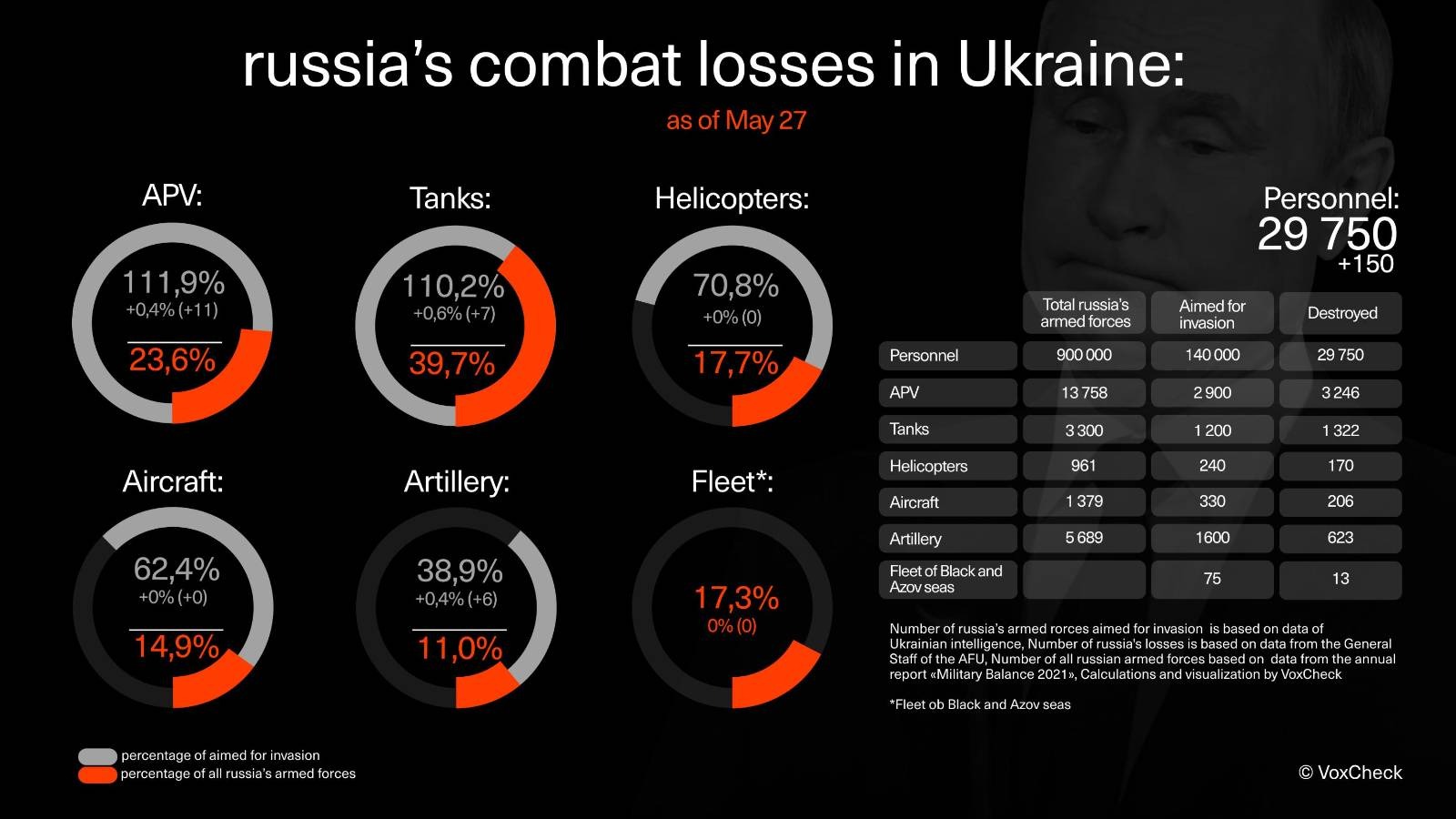
Russian enemy suffered the greatest losses (of the last day) in the Avdiivka direction.
Pentagon says Russia lost about 1,000 tanks in Ukraine, the Ukrinform reports. “Russian forces have lost nearly 1,000 tanks, over 350 artillery pieces, as well as almost three dozen fighter bomber fixed-wing aircraft and more than 50 helicopters so far in the ongoing war in Ukraine. That's according to CNN, referring to a senior US defense official. However, with all these losses, the US assesses that Russians "still have the … majority of their capability left to them. According to him, the Russians have superiority in terms of human and military resources.”
Humanitarian
Aggressors’ offensive in Donbas could make it uninhabited – Zelenskyy, the Ukrainska Pravda reports. "The current offensive of the aggressors in Donbas could make the region devoid of people. They want to reduce Popasna, Bakhmut, Lyman, Lysychansk, and Sievierodonetsk to ashes. Like Volnovakha, like Mariupol.
In cities and communities closer to the Russian border, in Donetsk and Luhansk, they are rounding up everyone they can to fill the place of those killed and wounded in the occupation contingent. All this, including the deportation of our people and the mass killings of civilians, is an obvious policy of genocide pursued by Russia."
According to UNHCR 6,659,220 refugees have been registered as of May 25. The UN says that so far Poland has taken in 3,544,995 refugees, Romania 978,407, Russian Federation 958,060, Hungary 660,192, Republic of Moldova 475,011, Slovakia 449,509 and Belarus 29,404. Among those who fled Ukraine are also Ukrainian nationals with dual citizenship. An additional 105,000 people moved to the Russian Federation from Donetsk and Luhansk oblasts between 18 and 23 February.
The number of Ukrainians entering Ukraine since February 28 is 2,156,500 as of May 24. This figure reflects cross-border movements, which can be pendular and does not necessarily indicate sustainable returns.
OHCHR recorded 8,691 civilian casualties in Ukraine as of May 25. 3,998 were killed (including 260 children) and 4,693 injured (including 404 children).
Environmental
Because of the Russians, Nova Kakhovka is partially flooded and Kherson is under threat, the Ukrainska Pravda reports.
Currently, one of the command centres of the Southern Military District of the Russian Federation, as well as the 49th enemy army, is deployed at the Kakhovka [U1] Hydroelectric Power Station. The Russians are not allowing repairmen to access two hydroelectric units at the Kakhovka HEP.
"The invaders are not making any effort to maintain the captured facilities in a safe state, which may lead to an environmental disaster, [according to Deputy Chief of the Main Operational Directorate of the Ukrainian General Staff, Oleksii Hromov, cited by Interfax-Ukraine.] Currently, large volumes of water are being discharged at the Kakhovska Hydroelectric Power Station captured by the invaders, as two hydroelectric units are not working and the invaders are not allowing them to be repaired. This has already led to partial flooding of Nova Kakhovka, the embankment and the local park. The surrounding villages and the occupied city of Kherson are under threat."
Russia's Putin and Italy's Draghi discuss ways to help solve the food crisis, the Reuters reports. "Vladimir Putin emphasized that the Russian Federation is ready to make a significant contribution to overcoming the food crisis through the export of grain and fertilizers, provided that politically motivated restrictions from the West are lifted, Moscow said in a statement.
Ukraine has described the Russian position as "blackmail" and British Foreign Secretary Liz Truss said on Thursday that Putin was "trying to hold the world to ransom" by weaponising the food crisis created by his war on Ukraine.
The White House said there were no talks being held about relaxing sanctions on Russia in order to secure grain exports.”
Black Sea ports are still the best way to get Ukraine's grain moving fast, the Reuters reports. Before Russia sent troops into Ukraine on Feb. 24, the country had the capacity to export up to 6 million tonnes of wheat, barley, and maize a month but exports collapsed to just 300,000 tonnes in March and 1.1 million in April.
“While the government wants to lift that to 2 million, it is hitting logistical bottlenecks ranging from a lack of train wagons, fuel, and trucks to freight wagons using a wider rail gauge than its neighbors, obstacles that could take years and billions of dollars to overcome.
At the moment,
Ukraine has at least 20 million tonnes of surplus grain in silos and the APK-Inform agricultural consultancy estimates another 40 million could be available for export once the next harvest comes in this summer. "There is hunger in Africa and other countries. We have seen the dynamics of a population missing that food from year to year," said Roman Rusakov, a senior official at Ukraine's Agriculture Ministry. "I just cannot imagine what might happen without Ukraine shipping next season's exportable surplus."
"Ports are necessary. But having said that we certainly will improve our railway logistics. Meantime, (river) ports will be in place to do a good job. But will it be enough to reach the target of like 6, 7 million a month? No way." he told Reuters. "The first task is to reach 2 million."
Wheat prices jumped to record highs in March and the surge in food prices has triggered protests across developing countries, as well as contributing to an acceleration in headline inflation rates throughout the world.”
Legal
Ukraine to cooperate with Britain in combating rape as a weapon of war – PGO, the Ukrinform reports. Ukraine and Britain will cooperate in combating the use of rape as a weapon of war, the Prosecutor General's Office of Ukraine states. “According to the PGO, during a visit to London, Prosecutor General Iryna Venediktova discussed with Deputy Prime Minister of the United Kingdom Dominik Raab and Foreign Office’s Minister of State for South Asia, North Africa, the United Nations and the Commonwealth Lord Ahmad of Wimbledon, the issue of deterring Russian aggression through prosecution.”
Ukrainian President’s Office expects an international tribunal for Putin to be set up this autumn, the Ukrainska Pravda reports. “The Office of the President of Ukraine expects that an international tribunal to punish top Russian military and political leaders for war crimes and an international arbitration court to convert the Russian Federation's frozen assets into compensation for Ukraine, will be established by the end of the summer, the deputy head of the Presidential Office Andrii Smirnov said to Radio Svoboda.”
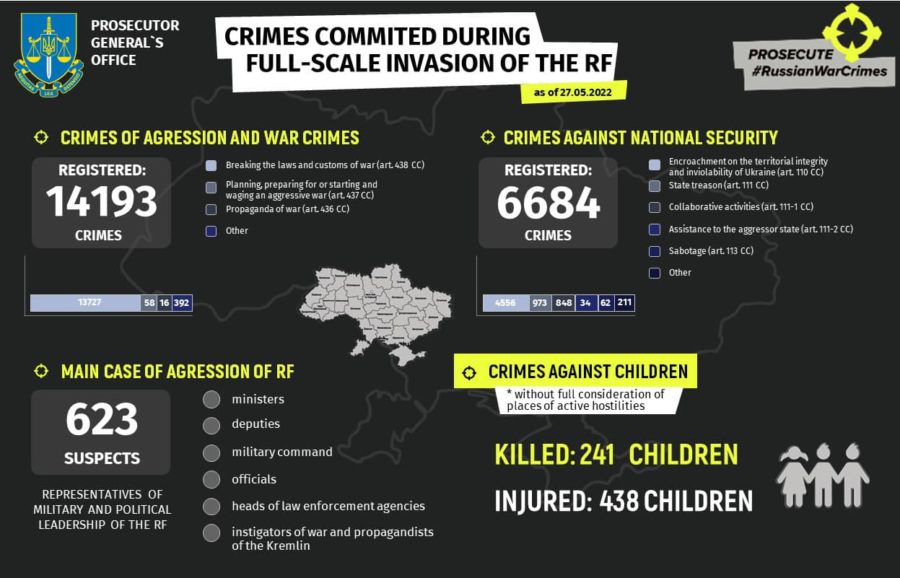
241 children were killed and 438 children injured, the Office of the Prosecutor General of Ukraine reports as of May 27. 1,887 educational establishments are damaged as a result of shelling and bombings, 180 of them are destroyed fully. 14,193 crimes of aggression and war crimes and 6,684 crimes against national security were registered.
Support
The US may approve the transfer of long-range rocket systems to Ukraine – CNN, the Ukrinform reports. According to CNN, the US presidential administration is preparing to increase arms supplies to Ukraine by sending advanced, long-range rocket systems to the country. “The administration is leaning toward sending the systems as part of a larger package of military and security assistance to Ukraine, which could be announced as soon as next week. The Biden administration wavered for weeks, however, on whether to send the systems, amid concerns raised within the National Security Council that Ukraine could use the systems to carry out offensive attacks inside Russia, officials said.”
Zaluzhnyi: It is very difficult for us, but we are standing. And we need weapons, the Ukrainska Pravda reports. “It is very difficult for us, but we are [still] standing. We are fighting for every section of the front, for every settlement. Western weapons and equipment are helping us drive the enemy out of our land.
We are grateful for the international technical assistance provided. At the same time, we are in dire need of weapons that are able to strike the enemy from a great distanse. And [delivery of] these cannot be delayed, because the price of any delay is measured in the lives of the people who have protected the world from Ruscism."
Finland will help restore Ukrainian cities, the Ukrinform reports. “Finland will help restore the infrastructure and Ukrainian cities and support the educational reform in Ukraine. This was discussed during a meeting between Prime Minister of Ukraine Denys Shmyhal and Prime Minister of Finland Sanna Marin in Kyiv, the Government portal informs.”
EU can agree on the Russian oil embargo, or seek an alternative, Germany says, the Reuters reports. “The European Union can still strike a deal on a Russian oil embargo in the coming days or look to "other instruments" if no agreement is reached, Germany's economy minister Robert Habeck said at Group of Seven talks in Berlin on Thursday. He did not specify what those other instruments could be.
The EU executive European Commission proposed the embargo as the harshest sanction yet on Russia after its invasion of Ukraine. But talks have failed to produce a breakthrough so far, with Hungary, Moscow's closest ally in the EU, vetoing the move. Habeck said all EU countries had to reduce their oil dependency. Brussels has already proposed giving Hungary, Slovakia, and the Czech Republic more time to impose an embargo, compared with other EU states.”
New developments
- Moscow expects Kyiv to accept the occupation of territories, the Ukrainska Pravda reports. "Moscow expects Kyiv to accept Moscow's demands and accept the de facto situation - the real situation that exists," [Vladimir Putin's spokesman, Dmitry Peskov, said on “Mayak" radio]. Asked whether this applies to "territorial concessions", Peskov answered: "These are not territorial concessions, Kyiv needs to recognise the de facto situation and simply assess it soberly."
- “Stop playing” with Russia, end war: Zelenskyy tells West, the Reuters reports. “Zelensky's criticism of the West has mounted in recent days as the European Union moves slowly towards a possible Russian oil embargo and as thousands of Russian forces try to encircle two key eastern cities of Sievierodonetsk and Lysychansk. Ukraine will always be an independent state and it won't be broken. The only question is what price our people will have to pay for their freedom and what price Russia will pay for this senseless war against us," said Zelenskyy in a late-night address on Thursday. The catastrophic unfolding events could be still stopped if the world treated the situation in Ukraine as if it were facing the same situation [and] if the powers that be did not play around with Russia but really pressed to end the war."
- The military situation in East Ukraine is very bad - Ukrainian foreign minister, the Reuters reports. The military situation in eastern Ukraine is even worse than people say it is and the country needs heavy weapons now to effectively fight Russia, Foreign Minister Dmytro Kuleba said on Thursday.
- The White House expects minimal impact on the US and global economy from a Russia default, the Reuters reports. "We expect the impact on the US and the global economy to be minimal, given Russia has already been isolated financially, White House spokesperson Karine Jean-Pierre said in a press briefing on Thursday. The United States pushed Russia closer to the brink of a historic debt default on Wednesday by not extending its license to pay bondholders, as Washington ramps up pressure following Russia's actions in Ukraine.”
- WHO condemns Russia's aggression in Ukraine in a rare vote, the Reuters reports. “A World Health Organization assembly on Thursday voted to adopt a Western-led resolution condemning Russia's actions in Ukraine which it says led to a health emergency. The resolution was approved by 88 votes in favour and 12 against, with 53 abstentions.”
- Finland’s PM on Russia: Trust is lost for generations, the Ukrinform reports. Russia’s war against Ukraine is a “turning point” for Europe. It has changed the security environment, as well as the perception of Russia. This was stated by Prime Minister of Finland Sanna Marin, who spoke at a joint briefing with her Ukrainian counterpart Denys Shmyhal in Kyiv on Thursday. “Trust is lost for generations,” Marin stressed.
Assessment
On the War
The Institute for the Study of War has made the following assessment as of Thursday 26 May:
Key Takeaways
- Russian forces unsuccessfully attempted to advance southeast of Izium near the Kharkiv-Donetsk Oblast border.
- Russian forces continued steady advances around Sievierodonetsk and likely seek to completely encircle the Sievierodonetsk-Lysychansk area in the coming days.
- Russian forces continued to make persistent advances south and west of Popasna toward Bakhmut, but the Russian pace of advance will likely slow as they approach the town itself.
- Russian forces in occupied areas of the Southern Axis are reportedly preparing a “third line of defense” to consolidate long-term control over the region and in preparation to repel likely future Ukrainian counteroffensives.“
US and Ukraine discuss the danger of escalation as new arms extend Kyiv's reach, the Reuters reports. “As the United States and its allies provide Ukraine with increasingly sophisticated arms, Washington has held discussions with Kyiv about the danger of escalation if it strikes deep inside Russia, the US and diplomatic officials tell Reuters.
The behind-the-scenes discussions, which are highly sensitive and have not been previously reported, do not put explicit geographic restrictions on the use of weapons supplied to Ukrainian forces. But the conversations have sought to reach a shared understanding of the risk of escalation, three US officials and diplomatic sources said. "We have concerns about escalation and yet still do not want to put geographic limits or tie their hands too much with the stuff we're giving them," said one of the three US officials, speaking on condition of anonymity.
President Joe Biden's administration and US allies have been increasingly willing to give Ukraine longer-range weaponry, including M777 howitzers, as Kyiv battles Russia's invasion forces with more success than American intelligence officials had predicted. The Pentagon's announcement last week that Denmark will provide Ukraine with Harpoon anti-ship missiles would further extend Kyiv's reach.
After initially forecasting Ukraine would be overrun by Russia's much bigger military, American officials have recently voiced hopes that Ukrainian forces can win the war and want to arm them to do so. US officials say the Biden administration is even
considering supplying Kyiv with the M142 High Mobility Artillery Rocket System (HIMARS), which depending on the munitions can have a range of hundreds of kilometers.
But US intelligence has also warned about growing risks, particularly given a mismatch between Russian President Vladimir Putin's apparent ambitions and the performance of his military. The coming months could put the war on a "more unpredictable and potentially escalatory trajectory," Director of National Intelligence Avril Haines told a Senate hearing this month.
The United States, by design, is not directly combating Russian forces but Pentagon commanders are in constant contact with Ukrainian leaders and have provided critical intelligence that has allowed Ukraine to target Russian troops, on land and at sea, US officials have said.
A second US official, also speaking on condition of anonymity, said Washington and Kyiv had a shared "understanding" about the use of certain Western-provided weapon systems. "So far, we've been on the same page about the thresholds," the official said. […]
Russian Foreign Minister Sergei Lavrov warned the West that supplying weapons to Ukraine capable of hitting Russian territory would be "a serious step towards unacceptable escalation," according to remarks published on the Russian foreign ministry website on Thursday. Russia has attacked Ukraine's capital and locations far from the front lines of fighting. But Ukraine has not reciprocated with attacks on a major Russian city or carried out strikes deep inside Russia, including on military targets such as weapons manufacturers or supply hubs far from the border. […]
The US sensitivities came into public view in April, when the Pentagon cited US intelligence warnings about the risk of a military escalation between Russia and the NATO alliance if the United States transferred fighter jets to Ukraine. […]
"We should reiterate, as we do in all cases, that these weapons should be used responsibly," said Crow, a veteran Army Ranger who sits on the Armed Services Committee and the House Permanent Select Committee on Intelligence in Congress. "But I'm less concerned about the issue of escalation than making sure that Ukrainians can win now and push back the Russian forces." The first US official said Ukraine had plenty of targets to hit inside Ukraine and that was the goal of obtaining longer-range weaponry from Western allies.
Douglas Lute, a former US ambassador to NATO and retired Army lieutenant general, agreed Ukraine has enough Russian targets inside Ukraine to worry about. But he acknowledged the risk of escalation and political division inside NATO should Ukraine strike deep inside Russia. "It would spark a divisive debate inside the alliance. And, of course, the alliance doesn't want that. And neither does Ukraine," Lute told Reuters.
One remaining question is whether Ukraine could change its strategy if the war takes a turn for the worse, perhaps using US-provided weaponry in ways not originally intended. "There could be scenarios where the Ukrainians are backed into such a corner that they feel they have to escalate further, but we haven't seen that yet," the second US official said.”
Consequences and what to do?
Fissures emerge over what constitutes victory in Ukraine, The New York Times reports. Three months into Russia’s invasion of Ukraine, America, and its allies are quietly debating the inevitable question: How does this end?
In recent days, presidents, and prime ministers as well as the Democratic and Republican Party leaders in the United States have called for victory in Ukraine. But just beneath the surface are real divisions about what that would look like — and whether “victory” has the same definition in the United States, in Europe and, perhaps most importantly, in Ukraine.
In the past few days alone there has been an Italian proposal for a cease-fire, a vow from Ukraine’s leadership to push Russia back to the borders that existed before the invasion was launched on Feb. 24 and renewed discussion by administration officials about a “strategic defeat” for President Vladimir V. Putin — one that would assure that he is incapable of mounting a similar attack again.
After three months of remarkable unity in response to the Russian invasion — resulting in a flow of lethal weapons into Ukrainian hands and a broad array of financial sanctions that almost no one expected, least of all Mr. Putin — the emerging fissures about what to do next are notable.
At their heart lies a fundamental debate about whether the three-decade-long project to integrate Russia should end. At a moment when the US refers to Russia as a pariah state that needs to be cut off from the world economy, others, largely in Europe [read: France], are warning of the dangers of isolating and humiliating Mr. Putin.
That argument is playing out as American ambitions expand. What began as an effort to make sure Russia did not have an easy victory over Ukraine shifted as soon as the Russian military began to make error after error, failing to take Kyiv. The administration now sees a chance to punish Russian aggression, weaken Mr. Putin, shore up NATO and the trans-Atlantic alliance and send a message to China, too. Along the way, it wants to prove that aggression is not rewarded with territorial gains.
The differences over war aims broke into the open at the World Economic Forum in Davos this week, as Henry Kissinger, the 99-year old former secretary of state, suggested that Ukraine would likely have to give up some territory in a negotiated settlement, though he added that “ideally the dividing line should be a return to the status quo” before the invasion, which included the Russian annexation of Crimea in 2014 and the seizure of parts of the Donbas. “Pursuing the war beyond that point would not be about the freedom of Ukraine, but a new war against Russia itself,’’ Mr. Kissinger concluded.
Almost immediately, President Volodymyr Zelensky of Ukraine accused Mr. Kissinger of appeasement, retorting angrily that “I get the sense that instead of the year 2022, Mr. Kissinger has 1938 on his calendar.’’ He was referring to the year Hitler began his sweep across Europe — the event that caused Mr. Kissinger, then a teenager, to flee with his family to New York. “Nobody heard from him then that it was necessary to adapt to the Nazis instead of fleeing them or fighting them.” [ME: The view expressed by Mr Kissinger – an individual – has been pushed back by several European state leaders many times already as both irresponsible and dangerous.] […]
Differing objectives, of course, make it all the more difficult to define what victory — or even a muddled peace — would look like. And they foreshadow a coming debate about what position Mr. Zelenskyy and his Western allies would take if negotiations to end the conflict finally get going. If Mr. Zelenskyy agreed to some concessions, would the United States and its allies lift many of their crushing sanctions, including the export controls that have forced Russia to shutter some of its factories for building tanks? Or would doing that doom their hopes of crippling Russia’s future capabilities?
In the end, American officials say, the hard choices will have to be made by Mr. Zelenskyy and his government. But they are acutely aware that if Mr. Putin gets his land bridge to Crimea, or sanctions are partially lifted, Mr. Biden will be accused by Republican critics — and perhaps some Democrats — of essentially rewarding Mr. Putin for his effort to redraw the map of Europe by force.
The debate is breaking out just as the shape of the war is changing, once again.
Three months ago, Mr. Putin’s own strategic objective was to take all of Ukraine — a task he thought he could accomplish in mere days. When that failed in spectacular fashion, he retreated to Plan B, withdrawing his forces to Ukraine’s east and south. It then became clear that he could not take key cities like Kharkiv and Odesa. Now the battle has come down to the Donbas, the bleak, industrial heartland of Ukraine, a relatively small area where he has already made gains, including the brutal takeover of Mariupol and a land bridge to Crimea. His greatest leverage is his naval blockade of the ports Ukraine needs to export wheat and other farm products, a linchpin of the Ukrainian economy and a major source of food for the world.
So far, with Russia gaining ground, there is no evidence yet that Mr. Putin is willing to enter negotiations. But pressure will build as sanctions bite deeper into his energy exports and the cutoff of key components hampers weapons production for his depleted military.
“Putin, whether we like it or not, will have to bring home some bacon and Mariupol is a small slice, but a slice,” Dov S. Zakheim, a former senior official in the Defense Department, said in a recent interview. “And the cost to Ukraine of life and matériel will continue to increase. So it’s a difficult political decision for Ukraine.”
[Hans Petter Midttun: No it is not. Ukraine knows it is fighting for its right to exist. Continue fighting is not a difficult decision to make. Ukraine has laid down its red lines and concessions are – despite The New York Times speculation otherwise –presently not on the table. But it is right to highlight the fact that the West has not defined what a victory looks like. I have made the same observations as I argue that the Western strategy is inconsistent with some of the declared objectives of the support for the country. Ukraine has, however, clarified its perspective of a victory.]
Hans Petter Midttun’s assessment
The West continue to be concerned about the risk of escalation. The first is related to the risk of escalation if NATO starts acting according to its strategic concept and engages in an UN-mandated humanitarian intervention in Ukraine and establishes a No-Fly Zone in its airspace. The second concern is linked to the risk of escalation if the West delivers weapons enabling Ukraine to hypothetically attack targets in the depth of Russia.
It reminds me of the classic excuse made by children: “The fight started when he hit back”.
Russia has waged hybrid war against the West for a decade and declared the West a party to the conflict.
The West already helps kill Russians on Ukrainian soil by providing Ukraine with tanks, artillery, MANPADS, anti-armor weapons, small arms and more. It helps defeat Russia by making it the most sanctioned country in the history of mankind. It is being economically crippled, isolated, and denied access to Western technology. In sum, the sanctions imposed by the West and the ongoing policy shifts constitute an existential threat to the Russian Federation.
Still, we are reluctant to deliver weapons that might help Ukraine defeat Russia quicker rather than later, thereby accepting that the multiple ripple effects from the world will increase in scope and severity.
In my opinion, our deliberations are comparable to us delaying rescuing refugees from a sinking ship while we were discussing the potential ramifications of bringing them to safety. At one stage we might realize that the rescue operation failed.
Both Russia and Ukraine are mobilising to meet future needs and prepare for what always was a protracted war. Ukraine is not only asking for weapons to replace losses but also weapons to equip new formations to meet the future onslaught. Most of all, however, it is asking for help to cut the war short. As Ukraine has clearly stated, Russia will continue fighting until it realises that they have lost. That realisation is closely linked to Western determination to support Ukraine until the end.
Any talk about concessions has the exact opposite effect. Weapon support without the full range of tools needed to win also helps undermine its support.
Both initiatives will be conceived as half-hearted attempts to “do the right thing” while – in the tradition of Western cynicism – countries continue prioritising national interests over international law and common principles and values.

